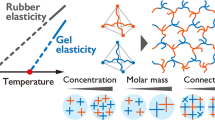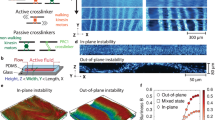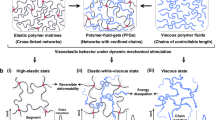Abstract
Many polymer gels undergo reversible, discontinuous volume changes in response to changes in the balance between repulsive intermolecular forces that act to expand the polymer network and attractive forces that act to shrink it. Repulsive forces are usually electrostatic or hydrophobic in nature, whereas attraction is mediated by hydrogen bonding or van der Waals interactions. The competition between these counteracting forces, and hence the gel volume1,2,3, can thus be controlled by subtle changes in parameters such as pH (ref. 4), temperature5, solvent composition6 or gel composition7. Here we describe a more direct influence on this balance of forces, by showing that the radiation force generated by a focused laser beam induces reversible shrinkage in polymer gels. Control experiments confirm that the laser-induced volume phase transitions are due to radiation forces, rather than local heating, modifying the weak interactions in the gels, in agreement with previous observations of light-induced chain association in polymer solutions8,9. We find that, owing to shear-relaxation processes10, gel shrinkage occurs up to several tens of micrometres away from the irradiation spot, raising the prospect that the combination of stimuli-responsive polymer gels and laser light might lead to new gel-based systems for applications such as actuating or sensing.
This is a preview of subscription content, access via your institution
Access options
Subscribe to this journal
Receive 51 print issues and online access
$199.00 per year
only $3.90 per issue
Buy this article
- Purchase on Springer Link
- Instant access to full article PDF
Prices may be subject to local taxes which are calculated during checkout




Similar content being viewed by others
References
Schild, H. G. Poly(N-isopropylacrylamide): experiment, theory and applications. Prog. Polym. Sci. 17, 163–249 (1992).
Ilmain, F., Tanaka, T. & Kokufuta, E. Volume transition in a gel driven by hydrogen bonding. Nature 349, 400–401 (1991).
Takeoka, Y. et al. First order phase transition and evidence for frustrations in polyampholytic gels. Phys. Rev. Lett. 82, 4863–4865 (1999).
Annaka, M. & Tanaka, T. Multiple phases of polymer gels. Nature 355, 430–432 (1992).
Suzuki, A. & Tanaka, T. Phase transition in polymer gels induced by visible light. Nature 346, 345 –347 (1990).
Hirokawa, Y. & Tanaka, T. Volume phase transition in a non-ionic gel. J. Chem. Phys. 81, 6379– 6380 (1984).
Hirotsu, S., Hirokawa, Y. & Tanaka, T. Volume-phase transition of ionized N-isopropylacrylamide gels. J. Chem. Phys. 87, 1392– 1395 (1987).
Smith, T. A., Hotta, J., Sasaki, K., Masuhara, H. & Itoh, Y. Photon pressure-induced association of nanometer-sized polymer chains in solutions. J. Phys. Chem. B 103, 1660–1663 (1999).
Hofkens, J., Hotta, J., Sasaki, K., Masuhara, H. & Iwai, K. Molecular assembling by the radiation pressure of a focused laser beam: poly(N-isopropylacrylamide) in aqueous solution. Langmuir 13, 414–419 ( 1997).
Shibayama, M. & Tanaka, T. Volume phase transition and related phenomena of polymer gels. Adv. Polym. Sci. 109, 1–62 (1993).
Svoboda, K. & Block, S. M. Biological applications of optical forces. Annu. Rev. Biophys. Biomol. Struct. 23, 247–285 (1994).
Misawa, H. & Juodkazis, S. Photophysics and photochemistry of a laser manipulated microparticle. Prog. Polym. Sci. 24, 665–697 (1999).
Juodkazis, S., Shikata, M., Takahashi, T., Matsuo, S. & Misawa, H. Fast optical switching by a laser-manipulated microdroplet of liquid crystal. Appl. Phys. Lett. 74 , 3627–3629 (1999).
Ashkin, A. Acceleration and trapping of particles by radiation pressure. Phys. Rev. Lett. 24, 156–159 (1970).
Shen, Y. R. The Principles of Nonlinear Optics 366–379 (Wiley & Sons, New York, 1984).
Ishikawa, M., Misawa, H., Kitamura, N., Fujisawa, R. & Masuhara, H. Infrared laser-induced photo-thermal phase transition of an aqueous poly(N-isopropylacrylamide) solution in the micrometer dimension. Bull. Chem. Soc. Jpn 69, 59– 66 (1996).
Schild, H. G. & Tirrell, D. A. Microcalorimetric detection of lower critical solution temperatures in aqueous polymer solutions. J. Phys. Chem. 94, 4352–4356 (1990).
Fritze, M., Stern, M. B. & Wyatt, P. W. Laser-fabricated glass microlens arrays. Opt. Lett. 23, 1441–143 (1998).
Strobl, G. R. The Physics of Polymers 63–128 (Springer, Berlin, 1997).
Hu, Z., Zang, X. & Li, Y. Synthesis and application of modulated polymer gels. Science 269, 525–527 (1995).
Acknowledgements
This present work was supported in part by a grant under Priority Area Research “Photoreaction Dynamics” from the Ministry of Education, Science, Sports and Culture of Japan, by a NEDO (New Energy Industrial Technology Development Organization) regional consortium project ”Development of Ultrasensitive Micro-Integrated Analysis Systems”, and by the Satellite Venture Business Laboratory of the University of Tokushima.
Author information
Authors and Affiliations
Corresponding author
Supplementary Information
Rights and permissions
About this article
Cite this article
Juodkazis, S., Mukai, N., Wakaki, R. et al. Reversible phase transitions in polymer gels induced by radiation forces . Nature 408, 178–181 (2000). https://doi.org/10.1038/35041522
Received:
Accepted:
Issue Date:
DOI: https://doi.org/10.1038/35041522
This article is cited by
-
Electroactive dielectric polymer gels as new-generation soft actuators: a review
Journal of Materials Science (2021)
-
Advances in biomimetic stimuli responsive soft grippers
Nano Convergence (2019)
-
Plant leaves inspired sunlight-driven purifier for high-efficiency clean water production
Nature Communications (2019)
-
Two-wavelength infrared responsive hydrogel actuators containing rare-earth photothermal conversion particles
Scientific Reports (2018)
-
Simple multi-wavelength imaging of birefringence:case study of silk
Scientific Reports (2018)
Comments
By submitting a comment you agree to abide by our Terms and Community Guidelines. If you find something abusive or that does not comply with our terms or guidelines please flag it as inappropriate.



